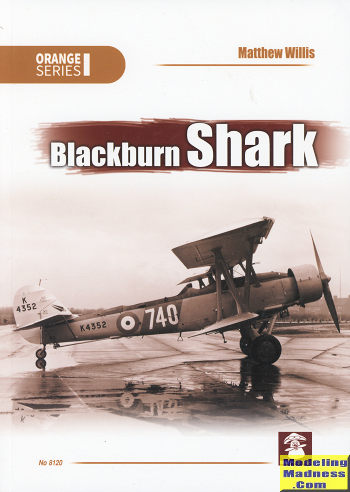 For much of
the interwar period, Blackburn was a supplier of aircraft for British naval air.
The designs may not have been esthetically pleasing, but they were capable of
doing the job required better than anyone else at the time.
For much of
the interwar period, Blackburn was a supplier of aircraft for British naval air.
The designs may not have been esthetically pleasing, but they were capable of
doing the job required better than anyone else at the time. MMP's Blackburn Shark
|
Author: |
Matthew Willis |
|
Publisher |
Mushroom Models Publications |
|
Price |
$25.00 from www.casematepublishing.com |
|
Reviewer: |
|
| Notes: | 104 pages, Softbound. ISBN: 978-83-65958-31-0, #8120 |
 For much of
the interwar period, Blackburn was a supplier of aircraft for British naval air.
The designs may not have been esthetically pleasing, but they were capable of
doing the job required better than anyone else at the time.
For much of
the interwar period, Blackburn was a supplier of aircraft for British naval air.
The designs may not have been esthetically pleasing, but they were capable of
doing the job required better than anyone else at the time.
Around the early-1930s, funding was very tight and so the idea of a multi-purpose aircraft became very much in vogue for the Navy. Rather than separate aircraft for reconnaissance, gunnery spotting, and torpedo attack, a tender was put out for a plane that would do all three. The first attempt came up with aircraft that did not meet all the needs, especially in terms of speed and range. A second attempt produced a clear winner, and that was the aircraft from Blackburn.
The Blackburn aircraft was fairly large and designed to operate on either floats or wheels. It was also designed to accept either the Pegasus or Tiger radial engines. The Pegasus was preferred as the Tiger had reached the end of its development, but the Navy had a bunch of them so despite reliability issues, that is what powered the new Blackburn Shark.
Getting the aircraft into squadron service brought up several issues. One is that the previous recce and spotting units didn't know anything about launching torpedoes, so they had to take time to come up to speed, delaying readiness. Another is that there were some issues with the Mk.I's engine bearers either failing or having cracks that required them all to have them replaced.
The Mk.II and later Mk.III learned from this experience and produced quality airframes, though still plagued with the lack of reliability of the Tiger engine. In the end, the Shark was fairly quickly replaced by the Pegasus powered Fairey Swordfish, though they continued on in secondary tasks until near the end of the war.
The aircraft was also provided to Portugal and to Canada where the Mk. III was produced under license and with the Pegasus engine for local use.
One can rely on excellent research and great photos in MMP books and this one is no exception. The aircraft's development and eventual service is fully covered. In addition to the developmental history, we are provided with a history of each unit that flew the plane.
There are no extant examples, but the detail section of the book is quite complete through the use of period photos and illustrations. There is also a fairly large profiles art section that shows the various camouflage and markings schemes applied. You also get a section of 1/72 drawings of all the different variants.
For fans of the type or the era, I can very much recommend this one.
March 2020
Review book courtesy of www.casematepublishing.com You can get this book today at this link.
If you would like your product reviewed fairly and quickly, please contact the editor or see other details in the Note to Contributors.